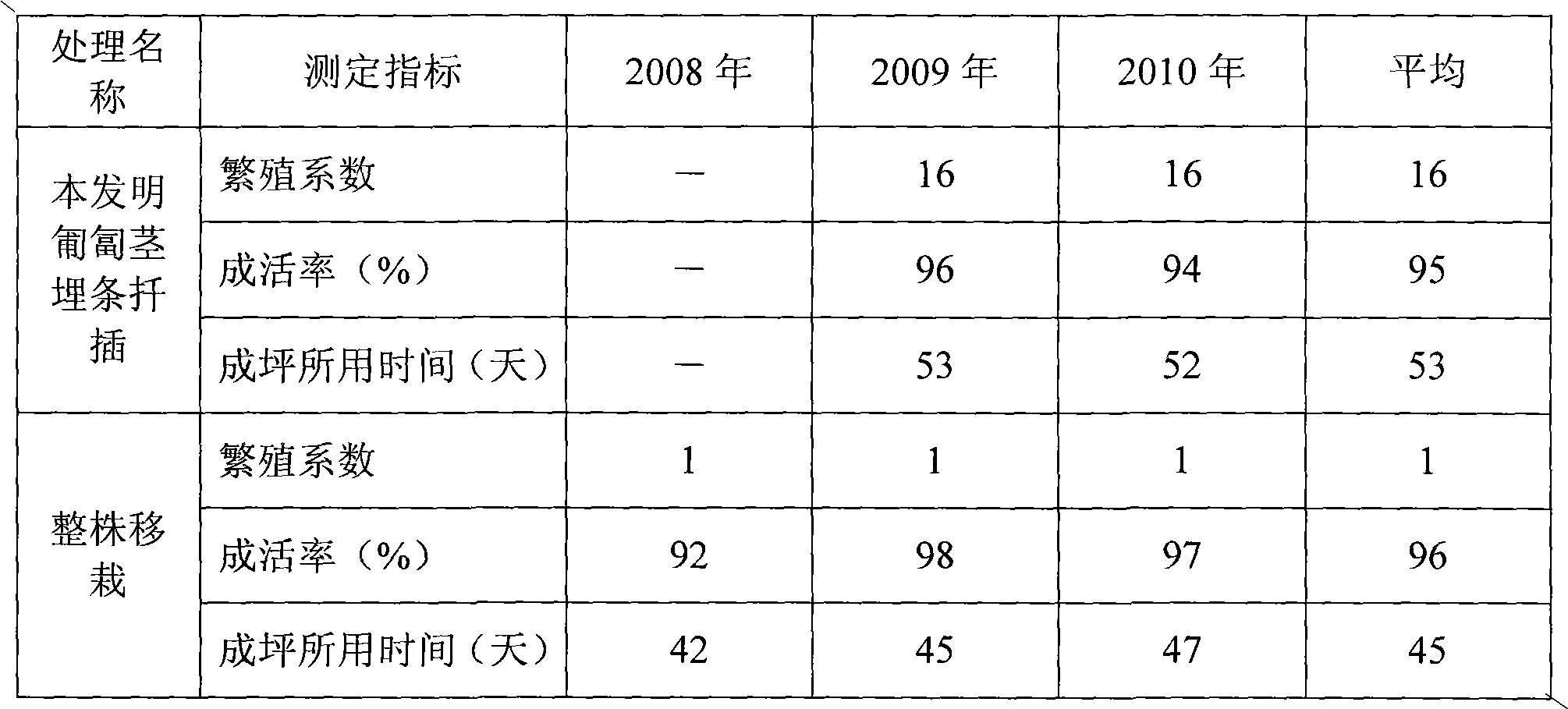Method for planting green lawn by using stolons of Potentilla centigrana Maxim
A technology of snakeberry and pottery stalks, which is applied in the field of greening lawn planting, can solve the problems of increasing the cost of reproduction, limiting the speed of propagation, and low reproduction coefficient, so as to reduce the cost of lawn construction, increase the reproduction coefficient, and manage extensively simple effect
- Summary
- Abstract
- Description
- Claims
- Application Information
AI Technical Summary
Problems solved by technology
Method used
Image
Examples
Embodiment 1
[0016] (1) Determine the planting period: the stolon on the mother plant of Snakeberry Potentilla grows to more than 30 centimeters, and when there are 4 stem nodes on the stem, the planting work begins;
[0017] (2) select stolon: select the stolon that grows vigorously, have 4 and more than 4 stem nodes, two stolons on every strain do not cut off, keep two stolons to be connected by mother plant root system;
[0018] (3) Soil preparation: fine-tune and rake the soil to remove weeds;
[0019] (4) Ditching and irrigation: open a 5 cm deep ditch, the distance between the ditch and the ditch is 30 cm, and then irrigate in the ditch;
[0020] (5) Cutting and embedding strips: After the water in the ditch has penetrated clean, place the selected stolons horizontally in the ditch, cover with 1-2 cm thick fine soil, and expose the leaves on each stem node to the outside of the soil;
[0021] (6) Covering and shading: After the cutting and embedding work is completed, cover it with ...
Embodiment 2
[0024] (1) Determine the planting period: the stolon on the mother plant of Snakeberry Potentilla grows to more than 30 centimeters, and when there are 4 stem nodes on the stem, the planting work begins;
[0025] (2) select stolon: select the stolon that grows vigorously, have 4 and more than 4 stem nodes, two stolons on every strain do not cut off, keep two stolons to be connected by mother plant root system;
[0026] (3) Soil preparation: fine-tune and rake the soil to remove weeds;
[0027] (4) ditching and irrigation: open a 4 cm deep ditch, the distance between the ditch is 25 cm, and then irrigate in the ditch;
[0028] (5) Cutting and embedding strips: After the water in the ditch has penetrated clean, place the selected stolons horizontally in the ditch, cover with 1-2 cm thick fine soil, and expose the leaves on each stem node to the outside of the soil;
[0029] (6) Covering and shading: After the cutting and embedding work is completed, cover it with a shading net;...
Embodiment 3
[0032] (1) Determine the planting period: the stolon on the mother plant of Snakeberry Potentilla grows to more than 30 centimeters, and when there are 4 stem nodes on the stem, the planting work begins;
[0033] (2) select stolon: select the stolon that grows vigorously, have 4 and more than 4 stem nodes, two stolons on every strain do not cut off, keep two stolons to be connected by mother plant root system;
[0034] (3) Soil preparation: fine-tune and rake the soil to remove weeds;
[0035] (4) Ditching and watering: open a 6 cm deep ditch with a distance of 35 cm between the ditch and then irrigate in the ditch;
[0036] (5) Cutting and embedding strips: After the water in the ditch has penetrated clean, place the selected stolons horizontally in the ditch, cover with 1-2 cm thick fine soil, and expose the leaves on each stem node to the outside of the soil;
[0037] (6) Covering and shading: After the cutting and embedding work is completed, cover it with a shading net; ...
PUM
 Login to View More
Login to View More Abstract
Description
Claims
Application Information
 Login to View More
Login to View More - R&D
- Intellectual Property
- Life Sciences
- Materials
- Tech Scout
- Unparalleled Data Quality
- Higher Quality Content
- 60% Fewer Hallucinations
Browse by: Latest US Patents, China's latest patents, Technical Efficacy Thesaurus, Application Domain, Technology Topic, Popular Technical Reports.
© 2025 PatSnap. All rights reserved.Legal|Privacy policy|Modern Slavery Act Transparency Statement|Sitemap|About US| Contact US: help@patsnap.com

